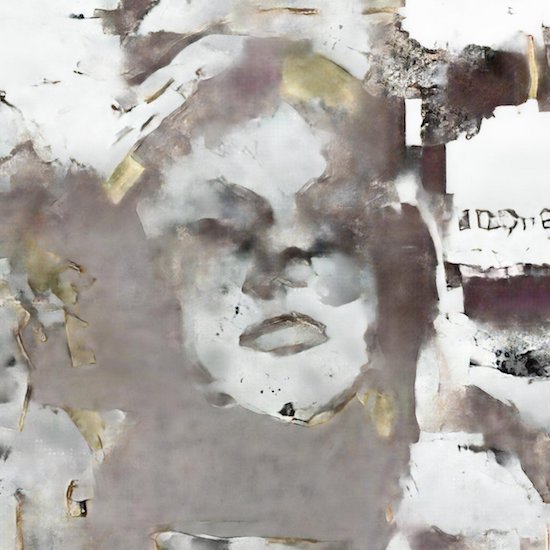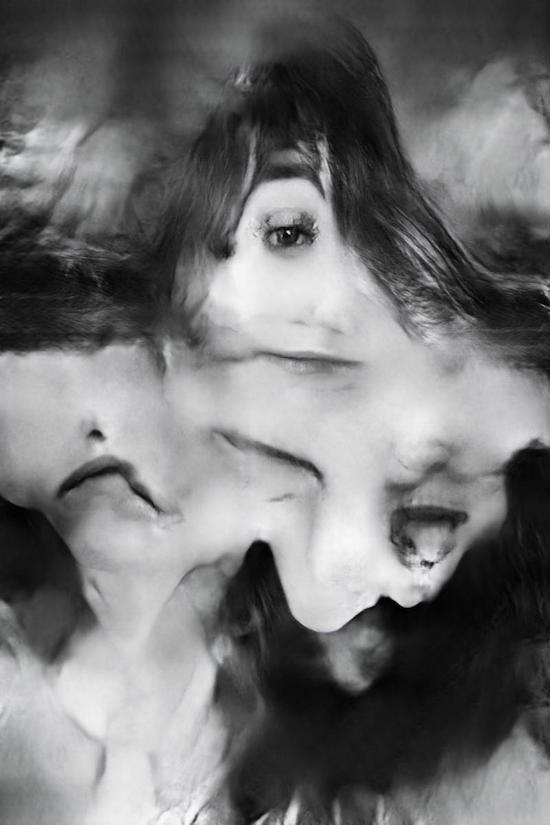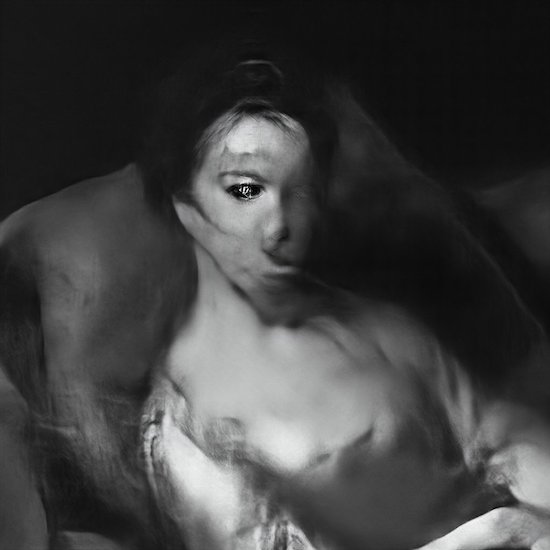When Mario Klingemann concluded his keynote speech at the xCoAx 2018 conference in Madrid, an uncomfortable murmur floated above the audience. Discord had infected the hundred or so gathered artists and researchers, the vanguard at the intersection of “computation, communication, aesthetics, and X”. Klingemann, one of the most notable proponents of machine learning and artificial neural networks in (visual) arts, blithely showcased an intriguing cornucopia of computer generated art. Deformed figures, idiosyncratically recreated portraits in the distorted style of old masters, and eerie abstract pieces dominate his work. Yet the artworks themselves seemed to drift out of focus during the discussion that ensued. It was the process that led to them that was contested.
As is customary for debates concerning the use of artificial intelligence techniques in art, two camps emerged. On one side, budding techno-utopians with an almost naive fascination with the creative potentials of the technology. On the other, a new generation of luddites reflective of the fear of AI, its dehumanising effects and untiring perfection creeping over the fallibility of humans. It was not a surprise, then, that after computer art pioneer Frieder Nake rose from his seat and with a thespian’s poise asked “Is this the end of art?” his question was met with both cheers and puzzled looks, revealing just how controversial this emerging field of art is.
However, Klingemann’s base approach to computer generated art frequently eschews this discussion and remains pragmatic. The algorithms he employs become mere extensions of his own creativity, not a change in paradigm. “I’m basically constantly refining my methods of producing more interesting arrangements of pixels. I want to see interesting images, different images, and I want to understand this meaningful idea of what information aesthetics are. What is it in images that makes fine art and makes us interested in them. It’s not just about the pixels themselves, it’s about what they mean and the story they tell,” he explains during a conversation a few weeks after xCoAx.
As a self-taught artist and designer who has worked with computers his whole life, the art he makes is in a state of constant evolution, following advances in technology yet retaining a unique style. Klingemann, along with peers like Memo Akten, Robbie Barrat, Gene Kogan, and Mike Tyke, builds and repurposes software based on deep learning and neural networks that he then floods with existing data, such as paintings, videos, and drawings, and finally curates its output. There is a sense of ephemerality in his work as he frequently scraps and rebuilds his models. Once he fully masters a certain aspect of the technology, he moves on. “I’m trying to be ahead of the pack, enjoy the unspoiled landscape. I prefer to go into the unexplored wilderness before other people build houses and take care of the plumbing.”

The results of this simple transhumanist symbiosis are abstract digital paintings, simultaneously macabre and beautiful, in which remnants of the original data can be discerned. Distorted faces and mimicries of figures that are just slightly out of phase mesh with replicas viewed through a prism of alternative facts – “vague memories of paintings that never existed.” It’s the machine’s view of a neighbouring world. Despite its reliance on AI and computers, Klingemann’s art is ultimately very much human. “My personal sense of aesthetic is kind of nostalgic and almost conservative. I like certain types of colour schemes and certain types of composition. But I don’t want to just replicate, I look for ways to add to it,” he points out.
Because of this, his work with generative adversarial networks (GAN) – algorithms that can generate relatively authentic looking pictures, imitations of their input data – is simultaneously archetypal for the technology and retentive of his own unique aesthetic as he subverts and exploits their characteristics. “The most interesting stuff usually happens if the model is outside its defined range of values or pushed into areas it was not trained for. But it needs to be a deliberate decision. It allows me to explore different visual worlds and allows me to discover something that is aesthetically pleasing or disturbing – it’s a constant battle I fight.”
When the appearance of serendipitous elements in the machine’s output is concerned, Klingemann’s philosophy is that “there are typical things that neural networks do that I consider a fault – repetitive patterns, overemphasizing of certain elements, a certain GAN style. I work against it and figure out why certain things happen, trying to understand the technology and to exactly see which parts limit it to this potential output and where can I hack it or escape that aesthetic that it produces.” Evidently a perfectionist, almost obsessive in this quest, Klingemann exclaims “Happy accidents are nice, but I like to have control even over the accidents!”
But what would happen if we removed humans from the equation and machines started making art for themselves? Which aesthetic framework would be used to evaluate their works? Aside from Max Bense and Abraham Moles’s theory of information aesthetics – a largely failed attempt at algorithmic and empirical evaluation of the aesthetic values of a work of art – we are left with our own limited criteria. Klingemann is anthropocentric, unconcerned with the machine’s intrinsic taste and pretty adamant about his traditionalism as he points out, “I still want to please. Breaking rules for the sake of breaking rules is too easy. If it looks so confusing and ugly that I don’t even understand it, maybe you’ve found a new aesthetic, but in the end nobody wants to look at it. It’s either all about the visual pleasure or it’s still too early.” Similar to how quantum computers can solve problems, but humans cannot retrieve the information from them, the machine’s true aesthetics seem to remain, for now, a mystery.

With many still refusing to consider anything that lacks some dimension of physical activity and creative pain to be proper art – laptop musicians’ struggle with this phenomenon is now legendary – Klingemann’s efforts embrace a note of ambiguity. Like the Gogols in Hannu Rajaniemi’s Jean le Flambeur trilogy, uploaded and enslaved human minds used to execute complex computational tasks, it’s the computer and the algorithm that perform the often menial act of creation itself, driven by the artist’s desires. But for Klingemann, it’s just the focus that has shifted. “The whole process is the art. So much work that’s not visible in the final artifact,“ he explains, “the whole curating the data, selecting the architecture, changing the architecture, training the model… it’s all art. Even choosing neural networks to produce art that looks appealing is part of my art.”
Although his works are featured prominently as installations, hardware artifacts, or prints in the physical world, Klingemann uses his Twitter feed as his main exhibition space. It’s a constant stream of new artworks and bits and pieces of the thought process behind it. “I post single images, but for me it’s not really about the single artifact that the model produces, it’s more about the potential that this model can produce. If I would have to pick one thing that is the art, then it’s the trained model and the software around. Not the final image or video. It’s part of it, but it’s not what I call the art.”
With the machines’ ability to produce virtually infinite number of art pieces, the performative tasks of the artist fluctuate towards ancillary roles. “The artist becomes the curator of the machine. You are constantly faced with choices you have to make. Ten things look great and you have to pick one. When do you stop? You are the discriminator in this kind of adversarial construct.” It’s often a tedious and repetitive task, so much so that Klingemann created a Tinder-like app to help himself make these choices. But the process is not without risk. “Machines can produce so much output. But there’s only so much attention and time. The more you see, the more it wears off. ‘More’ is not necessarily something you want to achieve.”
“I do not share my datasets, I do not share my models. If I give that away, everybody can go and exactly replicate my work,” Klingemann responds to questions about originality and sharing his model parameters. “Then it would be about ‘me’, then they say you have to touch the button to start it – it’s an artist cult. The magician doesn’t reveal how a trick is done. […] It has to feel something special. Once people can do them themselves, like filters [on Instagram], they lose appreciation.”
While Klingemann insists that he’s “not interested in political or sociological art” and “fields like bias, discrimination, surveillance […] all these hot topics right now,” these questions are inherent and deeply embedded in his art by virtue of the technology he uses. In a hermeneutical sense, the system narrates an autobiographical story, a satirical tale of the relationship between humans, art, and itself. At the same time, it exposes a multitude of contemporary society’s dreads.
Confronted with the first of these anxieties, the fear associated with concepts like “deep learning” and “artificial intelligence” and the way they are (mis)used to facilitate control and oppression of people, Klingemann responds: “When I start training the model, it’s not that I say I want to expose the bias or the dangers of surveillance. That might come once I see what the model is able to do. Because if I can do it, people with bigger budgets and less morals will abuse it. I’m recognising and vocalising that I know about this and adding context to the thing. People hopefully will see: it is beautiful, but there’s also a problem with it.” Through this concept, an interesting dynamic emerges: “The audience, the observer is absolutely part of it. They finally close the loop or they see the meaning in it or recognise certain things that maybe even I haven’t recognised.”
In some of his other works, the biases and discrimination contained in the input data are inescapable, culled and made painfully evident. His convoluted digital portraits which the machine generates by analysing hundreds and thousands of original paintings become a distillation of a deeply ingrained patriarchy. “By accident I do political art – or, in some sense my art is kinda touching these issues. If I take my faces, they are all old and white. It is something that I’m working on trying to avoid. But on the other hand, if I want to achieve a certain aesthetic with paintings, I have to use this painting data as my training set.”
The debate surrounding the use of AI in art, the disquiet brought on by the uncanny valley and the fear of something alien obsoleting artists and replacing us all, seems moot for Klingemann. He counters “It’s actually exciting. There’s not that much alien stuff in the world and it has the potential to be a new kind of intelligence. There’s a certain fascination that humans have with different types of intelligence. Kind of like a mirror, what can it do that I cannot do? What am I better at than it? I don’t have to be afraid. Or do I?” He is resolute in his response, “I don’t have that fear, I’m curious. You do what you have to do. Because you enjoy it. A machine cannot take it away.”
When asked about his endgame and ultimate motivation, he says, “Humans are not special. That’s what I’m trying to prove. We can be tricked. If you arrange pixels in the right order, you’ll get something that can evoke emotions or pleasure or disgust or interest. Interestingness is the overarching theme. In a way, I try constantly to prove you don’t need a human to do that. […] Everything I worked towards is eventually getting there. All the steps that I took and the different techniques were my learning phase. I’m trying to build a creation machine that will constantly evolve itself, hopefully in ways that I and other people find interesting.”
Finally, I circle back to the question posed by Frieder Nake, a question that is crucial to understanding Klingemann’s art. Will computers and his “creation machine” bring on the “end of art?” Will they replace our creative processes? “One of the core components that are still missing for this general artistic AI is the ability of storytelling or understanding stories. A conceptual graph, some kind of story space, with lots of laws: What do we get out of a story? What elements do there have to be? My theory is about information flow between the actor, and the story, and the reader. It still needs some sort of technical breakthrough.”
He concludes with a thought that is perfectly crafted to soothe the eternal cynics: “If we ever were able to figure out the creative process that is so difficult to pinpoint, it would have to be replaced by something else. The whole point is that it is so hard to put your finger on it. If you can put it in a recipe, it’s becoming commodified and becomes boring again. It’s exactly the uncertainty that makes it so interesting. In that sense, we won’t be able to ever figure it out.”
Mario Klingemann is currently exhibiting as part of the group show Gradient Descent, at Nature Morte, New Delhi


